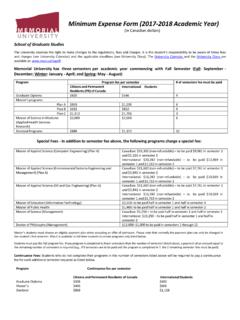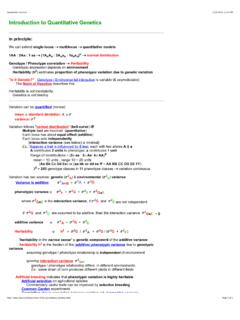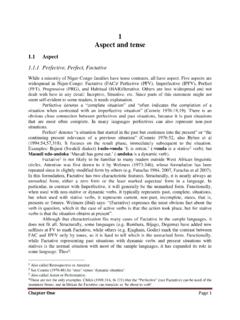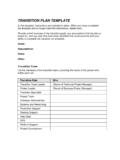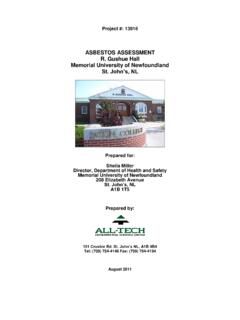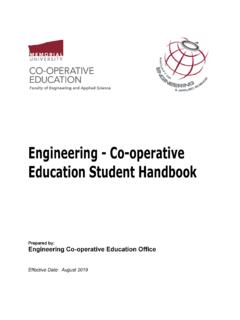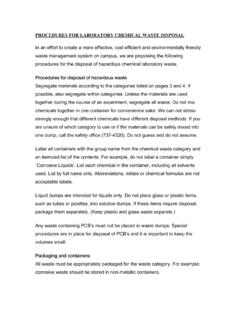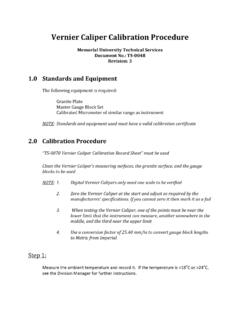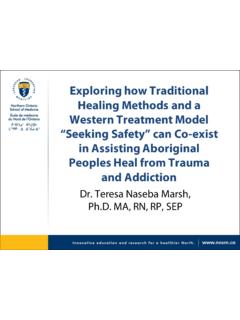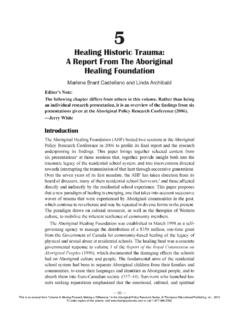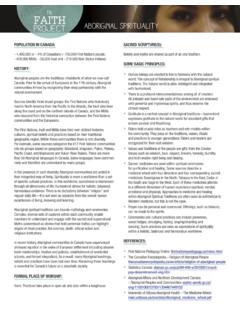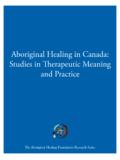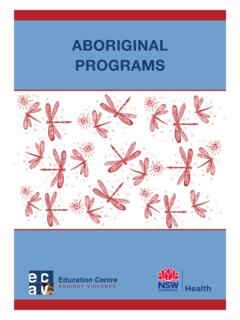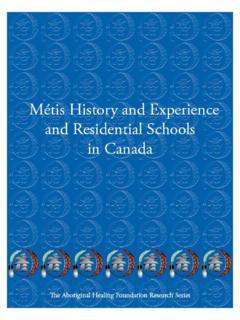Transcription of ABORIGINAL HEALING AND WELLNESS INITIATIVES …
1 ABORIGINAL HEALING AND WELLNESS INITIATIVESP resented by the ABORIGINAL HEALING and WELLNESS strategy andresearchers from the Centre for Applied Social Research, Facultyof Social Work, University of TorontoAboriginal HEALING and WELLNESS is an area of significant growthand activity among ABORIGINAL individuals and communities inCanada today. This presentation focuses on a unique policyiniatiative in the Province of Ontario, canada called theAboriginal HEALING and WELLNESS strategy (AHWS). Thepresentation has four sections:1. First we will provide an overview of the strategy , what itis, how it came about, and some of its distinct A number of team members will talk about their work incommunity-based HEALING and WELLNESS INITIATIVES whichreceive funding from the We will then report on the first phase of a longitudinalstudy which was contracted in order to understand theimpacts of the programs and services on those using Finally, we have a discussant who will help stimulatediscussion in an interactive presentation team is comprised of nine members, representingdifferent groups with varying relationships to the AboriginalHealing and WELLNESS Brant Castellano is our discussant.
2 Marlene isProfessor Emeritus at Trent University, a Mohawk from the Bay ofQuinte and holds many awards and Reavy represents the Joint Management Committee of the AHWSand works for the Ontario Ministry of Community and SocialServices, one of the strategy 's Pegahmagabow, Marion Maar and Steve Beaupr are fromcommunity-based projects which are involved in the longitudinalstudy. They are also members of the Longitudinal Working Groupthat oversees the longitudinal Richard, Lilian Wells, Suzanne Dudziak and Lynne Davis areall members of the Longitudinal Research Team from the Centrefor Applied Social Research, Faculty of Social Work, Universityof Toronto. Kenn Richard is also Executive Director of NativeChild and Family Services of written presentation that follows has been built from thespeakers' notes and from transcribed passages of thepresentation. Some sections follow closely the oralpresentation while others have been prepared for this overall presentation is divided into two parts.
3 The firstpart focuses on the overview of the strategy and the casestudies, with the following presentations:1. INTRODUCTION TO THE ABORIGINAL HEALING AND WELLNESSSTRATEGY by Pat Reavy2. AHWS AS A UNIQUE PARTNERSHIP by Suzanne Dudziak3. THE REWARDS AND CHALLENGES OF INTEGRATED SERVICE PROVISIONby Marion Maar and Debbi Pegahmagabow4. CASE STUDY: ENAAHTIG HEALING LODGE AND LEARNING CENTRE bySteve Beaupr 5. CASE STUDY: MOOKA AM PROGRAM, NATIVE CHILD AND FAMILYSERVICES by Kenn RichardThe second part of the presentation is research-oriented andtalks about the longitudinal GENESIS OF A PARTNERSHIP by Pat Reavy7. WALKING IN TWO WORLDS - PREPARING TO COLLECT DATA by LynneDavis8. LONGITUDINAL STUDY -- SOME KEY FINDINGS by DebbiPegahmagabow and Lilian Wells9. ETHICAL ISSUES IN ABORIGINAL RESEARCH by Kenn Richard andLynne DavisPART 1. OVERVIEW OF THE strategy AND CASE STUDIESINTRODUCTION TO THE ABORIGINAL HEALING AND WELLNESS STRATEGYby Pat Reavy, Joint Management Committee of the AboriginalHealing and WELLNESS ABORIGINAL HEALING and WELLNESS strategy (AHWS) is thesingle largest ABORIGINAL initiative undertaken by a province inCanada.
4 It is a unique partnership between on- and off-reserveAboriginal organizations and provincial ministries in goal of AHWS is to reduce family violence and improve healthstatus in ABORIGINAL communities. AHWS began in the fall of1993 and received approval for its second five-year phase inApril, the early 1990's the Ontario government acknowledged thatmainstream programs were not effective in addressing the issuesof high rates of family violence and poor health status inAboriginal communities. The government provided funding to bothon- and off-reserve organizations to consult with theircommunities about these issues. More than 5000 people in over200 communities, including mental health and correctionalfacilities, provided input in what was one of the most extensiveseries of consultations ever carried out with ABORIGINAL peoplein canada . The ABORIGINAL HEALING and WELLNESS strategy grewout of these consultations. It is an initiative which isdesigned, delivered, and managed by ABORIGINAL communities, forAboriginal people.
5 This lead the Royal Commission on AboriginalPeople to recommend AHWS as a service-delivery model that otherjurisdictions should consider in addressing ABORIGINAL healingand strategy has an annualized budget of $ million. It ismanaged by a Joint Management Committee composed ofrepresentatives from:. First Nations Provincial-Territorial organizations,Independent First Nations. off-reserve organizations representing non-status,Metis and women, and. four provincial ministriesAll AHWS policy, program, and funding decisions are determinedby the Joint Management want to demonstrate how programs and services changedconcretely in the first five years of the AHWS. The followingtable shows the network of services available to Aboriginalpeople in Ontario before and after the strategy :SpecializedProjectsBEFORE the StrategySpecializedProjectsAFTER the StrategyCommunity ProgramsAFTER the StrategyHealth Centres 2 HEALING Lodges 10 Community Workers(provinciallyfunded)Treatment Centres9(federally funded)Shelters 7(provinciallyfunded)Outpatient Hostels 2(federally funded)Shelters 9 Outpatient Hostels 3 Maternal & ChildCentres 1 Clearinghouse 1 Health AccessCentres 10 Crisis TeamsAnnualized GrantsHealth OutreachThis network ofservices are spreadthroughout OntarioAHWS has created a network of over 200 community and regionalhealth and social services in on- and off-reserve strategy promotes the inclusion of cultural, traditionalhealing and traditional medicine practices in all of theprograms it funds.
6 AHWS also strives to implement commonpriorities, while respecting the Tribal and cultural differencesamong ABORIGINAL people in various communities across theprovince. The specialized projects offered by AHWS includehealth centres, HEALING lodges, treatment centres, familyshelters, outpatient hostels, and medical translators, aninformation clearing-house, a recruitment service, a child andmaternal centre. These services are status-neutral. These areaccessible to on- and off-reserve ABORIGINAL populations(including Metis and Inuit) people in their respective catchmentareas and have created management structures that reflect thisprinciple. This is one of the unique characteristics of AHWSand one of its major AS A UNIQUE PARTNERSHIPby Suzanne DudziakThe ABORIGINAL HEALING and WELLNESS strategy stands out as aunique and successful partnership. While "partnership" iscurrently a popular buzz word, little attention has been paid tothe conditions that facilitate the effective collective work oforganizations who come together with different and oftencompeting interests.
7 The maintenance of partnership over asustained period of time is a unique and critical dimension ofAHWS' of the AHWS PartnershipAs noted in the Introduction, AHWS brought together all themajor First Nations and ABORIGINAL organizations (on-reserve,off-reserve, Metis, women) into an inclusive and collaborativepartnership with ministries of the Ontario government. Tenministries were involved initially; this was later reduced tofour closer to implementation. Following implementation, otherFirst Nations and ABORIGINAL organizations joined theinitiative. It is important to note that partnership in the AHWS contextinvolves multiple sets of social relations that, in addition tothe coming together of ABORIGINAL /government bodies, includesAboriginal organizations working together across diversehistories of oppression and cultural differences and governmentministries which rarely cooperate across mandates and a unique experience in policy-making, the AHWS partnershipwas constructed to engage in joint policy development; anapproach that moved far beyond the more typical input or consultation that government does with ABORIGINAL peoples.
8 Asa highly relational and process-oriented approach, joint policydevelopment challenges the more conventional technocratic andlinear approaches to social policy and the actual program and management level, the AHWS partnershipoperates on the principle of interdependence which not onlyallows for the needs of diverse communities to be met but alsoensures that programs are community-driven and can operateprovincial-wide, regionally and/or locally. In this regard, AHWS encourages the formation of partnerships among Aboriginalorganizations to establish and run programs that may serveseveral communities in a given area. For example, an off-reserve, urban friendship centre and a nearby rural First Nationmay choose to establish a family shelter in their has taken partnership to heart as a core modus operandiand put it into practice in deep, intensive and extensive for successful partneringBased on the reflections of 37 individuals who participated inthe five-year developmental phase of AHWS, several key insightsemerge with regard to the conditions which foster successfulpartnering (Dudziak 2000).
9 Given the complex cultural and political dynamics operating whensuch diverse groups and interests attempt to develop policytogether, dialogue and decision-making using consensus continuesto be considered very effective. In practice, consensus impliesseveral rounds of talking and deep listening over sometimessignificant periods of time. As participants commented, thisprocess facilitates greater understanding which results inbetter decisions, people feel heard effectively taking intoaccount many kinds of differences, which ultimately leads togreater equality and important learning for policy and planning theory is thatconsensus only really works when differences are fullyrecognized and brought into the discussion. Thus, consensusprovides a way to deal with heterogeneity without homogenizingor reducing different consensus is often critiqued by non- ABORIGINAL people as inefficient because it is process-oriented and time-consuming,both ABORIGINAL and non- ABORIGINAL participants involved in AHWS challenge this myth.
10 As an approach brought by the Aboriginalparticipants, consensus represents a respectful, culture-based,values-oriented way of proceeding. Less familiar to governmentrepresentatives, many found that consensus-based planningresulted in more effective and comprehensive planning. Incontrast to conventional linear policy-making and planningapproaches, they observed that many issues which are nottypically considered until implementation are able to beforeseen and dealt with during the design and development phaseas a result of the extensive dialogue that consensus decision-making learning generates a further insight. Policy analysis andespecially policy outcomes absorb much of the attention inactual policy-making practice and in the policy scienceliterature. Little attention is paid to the theory and practiceof policy development. Yet AHWS success is due in somesignificant measure to the fact that the partners put in fiveyears of planning and design work together, developing the kindsof practices and principles which proved to be workable.
